Soaring on the Wings of Giants—35 Years of the Taiwan Wild Bird Federation (Part 1)
By Scott Pursner, TWBF Director of International Affairs
Part 1: A Historical Review of Ornithological Study and Birdwatching Groups in Taiwan
Beginnings (1854-1895)
Ornithological study and documentation in Taiwan did not begin until the mid to late 1800s (6). There are a few major reasons for this. The first is that, though indigenous peoples have lived in Taiwan for thousands of years and have collected intimate knowledge of various species including birds, their records were not written. Later, when waves of immigration came to Taiwan in the 17th and 18th centuries, officials of the Qing court documented their observations of species, but these records were not very descriptive or scientific in nature, and sometimes referred to different species with the same names. Only when Western ornithologists and collectors came to Taiwan did the modern, scientific study of birds truly begin (6). The first such record took place on September 25, 1854, when a US Navy survey vessel passed through the seas of Taiwan. William Stimpson, a scientist on board, recorded observations of Little Terns and Barn Swallows (6).
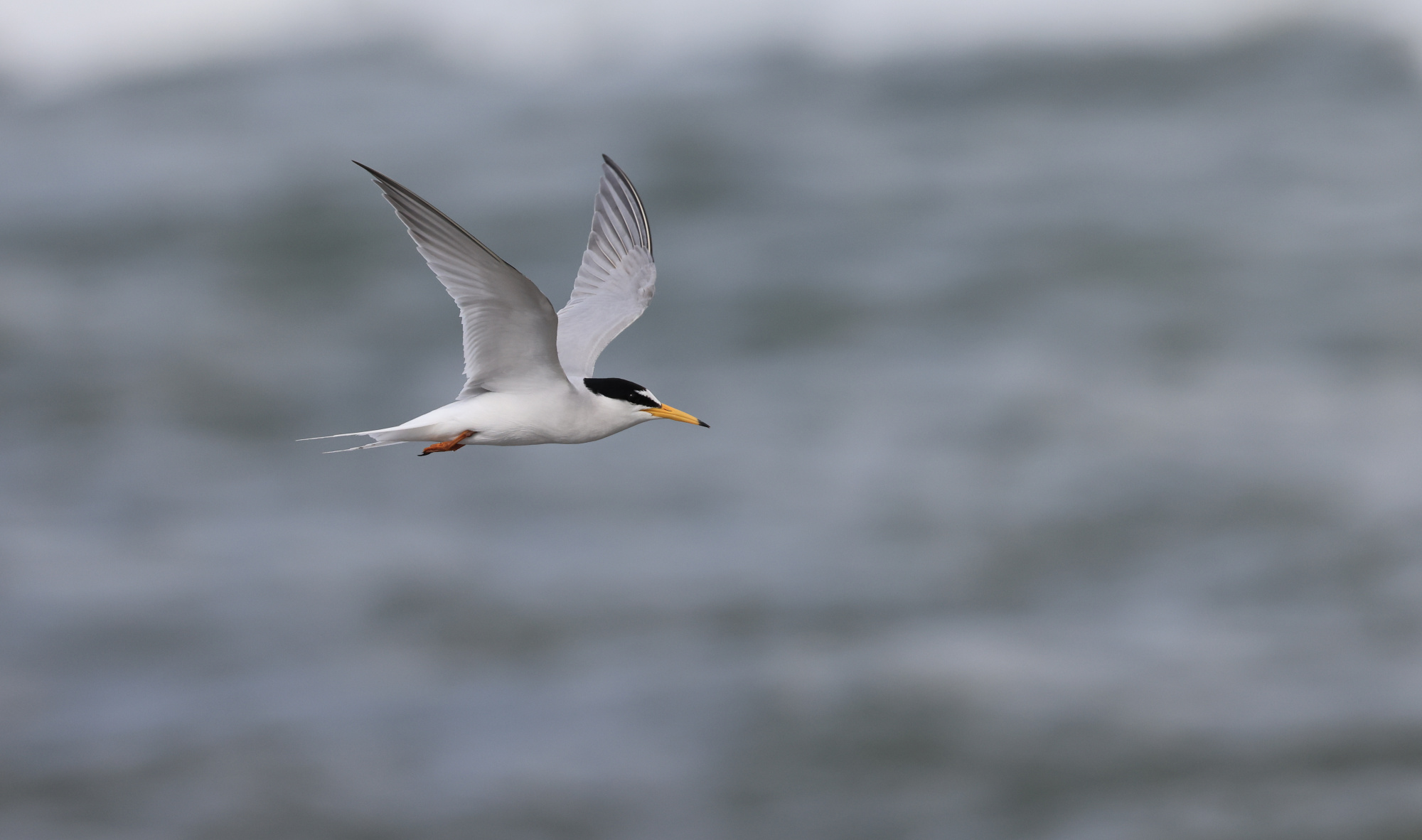
Little Tern (Source: TWBF)
Two years later Robert Swinhoe, a British diplomat, naturalist, and explorer, made his first trip to Taiwan and would later be credited with introducing Taiwan's birds to the world. Stationed in Kaohsiung from 1861 to 1866 as British Vice Consul, he described many of Taiwan's bird species for the first time in the British journal Ibis between 1860 and 1877. One of those articles was Taiwan's first bird checklist, "The Ornithology of Formosa, or Taiwan" which was published in 1863 (1, 2). At that point, the number of known species was 201 (1). He also described some now-widely known species such as the Black-faced Spoonbill and the Fairy Pitta, though he identified the latter as a type of Blue Pitta. By the end of his tenure, he had identified 226 species, including five endemic species. Due to his efforts, many species bear today his name (4).
After Swinhoe left, more researchers came. This included the 1873 visit by University of Michigan Professor Joseph Beal Steere (namesake of the endemic Steere's Liocichla), as well as the discovery by Swede A.P. Holst of the endemic Yellow Tit in 1893. When John David Digues La Touche served as British Consul to southern China from 1892 to 1895, he came to Taiwan three times and recorded over 100 species (4).
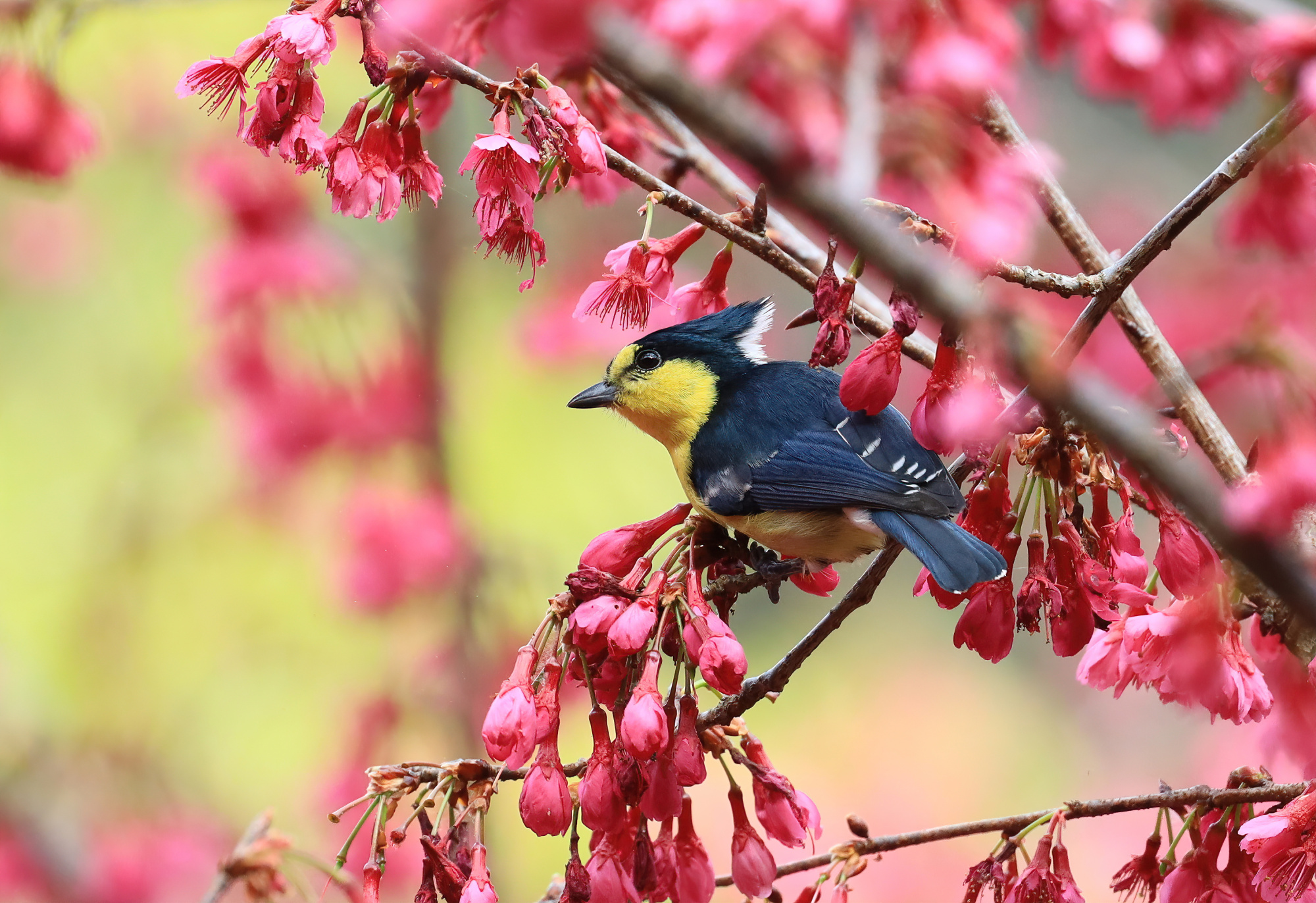
Endemic Yellow Tit (Source: TWBF)
The Japanese Colonial Period (1895-1945)
Prior to 1895, the Qing Dynasty controlled the western third of what is now Taiwan island, an area comprised mainly of plains, wetlands, coasts and foothills. It was therefore also the area where the majority of the period's ornithological study took place. This dynamic changed in 1895 when Japan, after defeating the Qing in the Sino-Japanese War, annexed Taiwan as part of the Japanese empire (4).
The new Japanese colonial government launched efforts to study its new colony's flora and fauna, including birds. In 1896, scholars Fujita Nobunobu and Namiye Motoyoshi of Tokyo Imperial University (today's University of Tokyo) published an article entitled "Report on Taiwan Animals in the New Imperial Territory" in the Japanese Journal of Zoology. It listed the known birds of Taiwan and translations of the works of Swinhoe and La Touche. This article can be regarded as the first attempt by the Japanese colonial administration to understand Taiwan's birds (4). That same year Tokyo Imperial University sent Tsunasuke Tada to Taiwan to collect animal specimens. He stayed in Taiwan for 17 months (6). Though he made no new discoveries, it still marked the first time that Japanese academics had investigated Taiwan's fauna (4).
In 1902, the first museum in Taiwan, the State Educational Museum, was founded in the southern city of Tainan by the Japanese (1). This museum became one of two main repositories for Taiwan's ornithological knowledge during the Japanese colonial period.
In January 1906, seasoned British collector Walter Goodfellow arrived in Taiwan. With an entourage of Japanese police and porters he made an expedition to east Asia's tallest mountain, Yushan or Jade Mountain (3,952 m). During this trip to Taiwan's mid- and high-elevation environments, he collected many bird species and discovered six new Taiwanese endemics (4), including the Mikado Pheasant. Its discovery sparked great interest among British collectors, including specimen trader Alan Owston who was based in Yokohama, Japan. He dispatched collector Kikuchi Yonetaro to Taiwan that November. Kikuchi captured over 20 Mikado Pheasants which were later sold to Europeans and Americans. They were the first specimens of male Mikado Pheasants known to Westerners (4, 6).
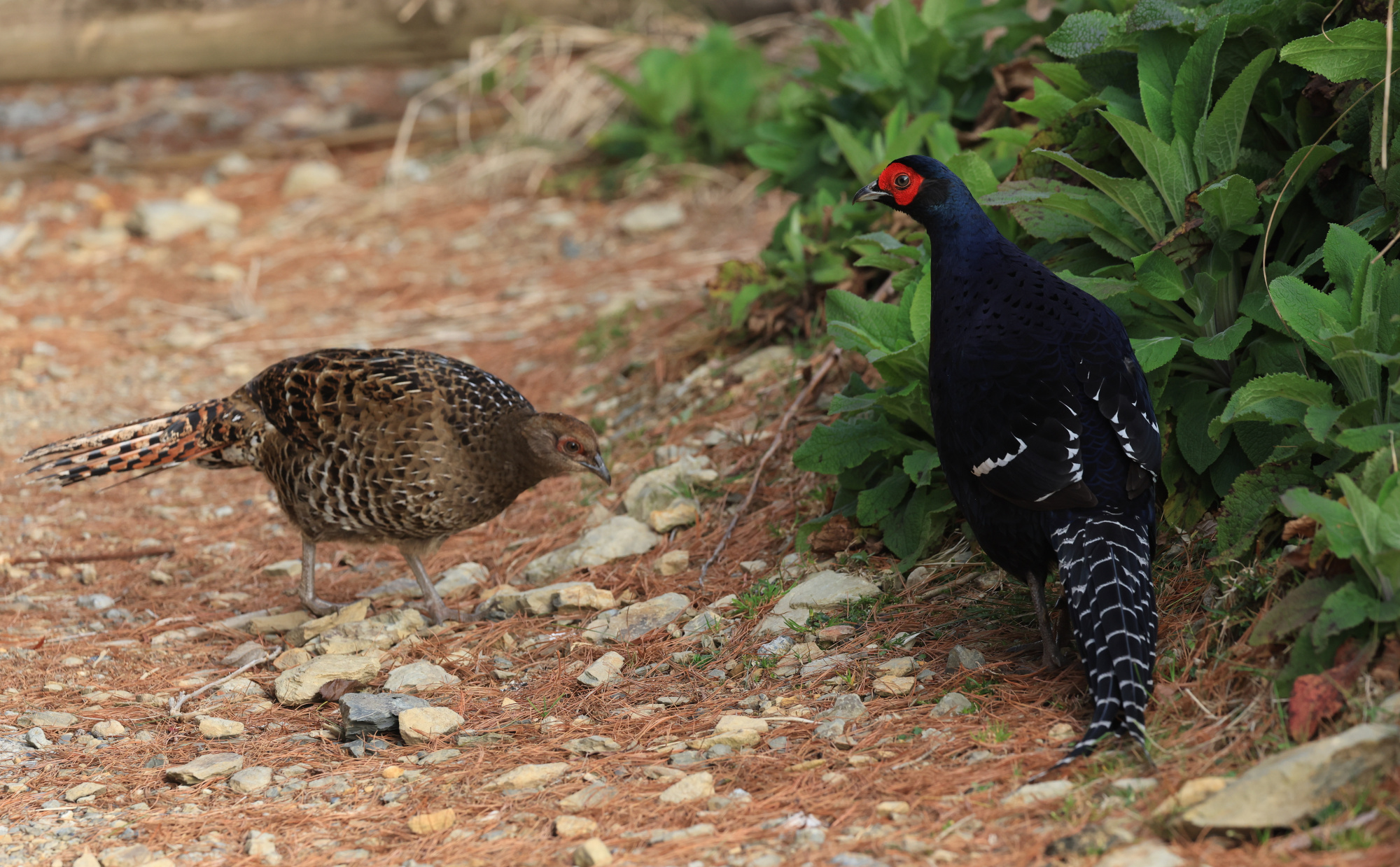
Endemic Mikado Pheasant (Female on left, male on right) (Source: TWBF)
In 1907, Scottish ornithologist William Robert Ogilvie Grant and La Touche compiled a new checklist for Taiwan's birds entitled "On the Birds of the Island of Formosa", again in the British journal Ibis. It described a total of 260 species (4).
In 1908, the Japanese colonial government established the Taiwan Governor Museum (today's Taiwan National Museum). Its early bird specimens were also supplied by Kikuchi (4).
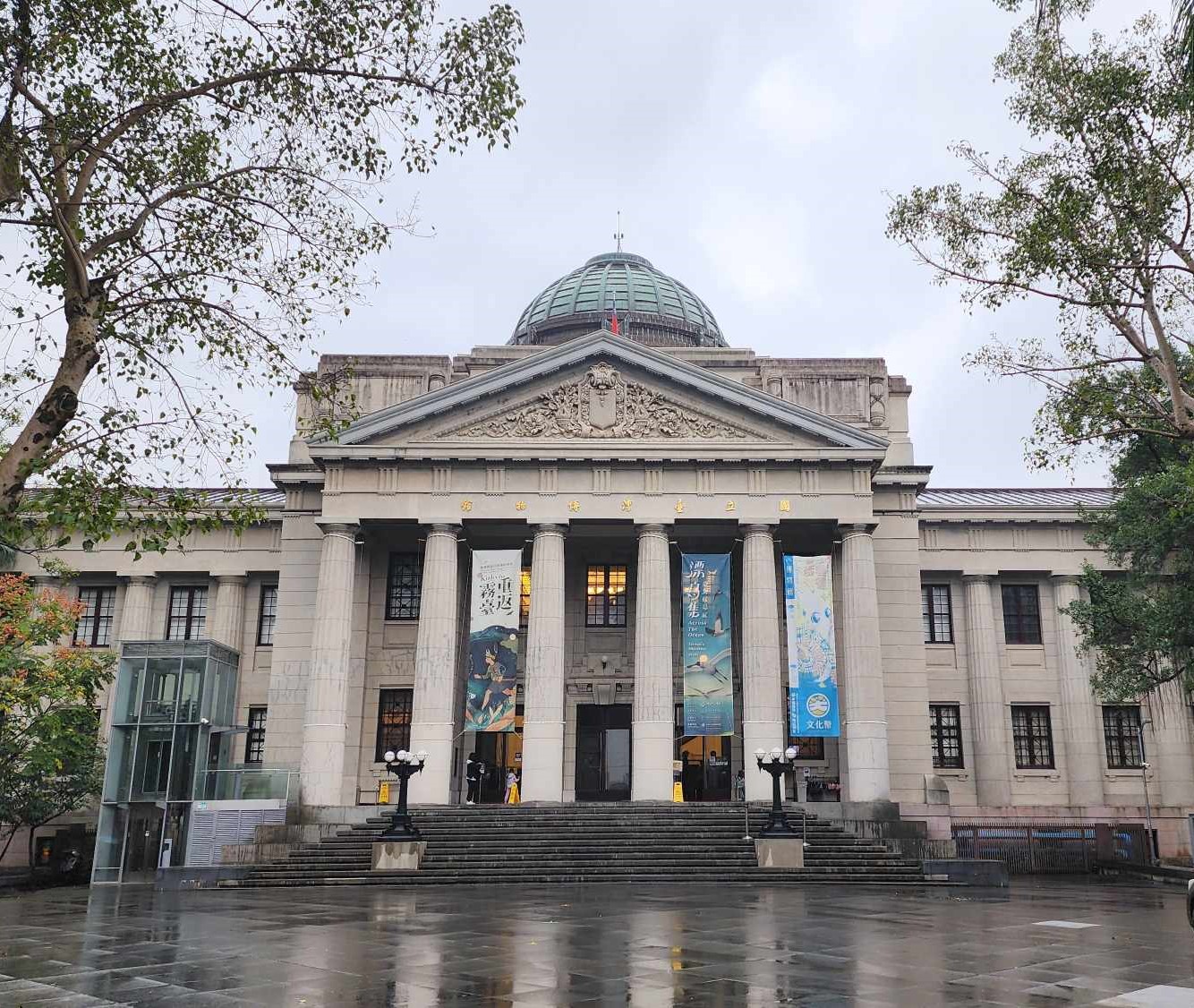
The National Taiwan Museum
In 1912 Goodfellow returned to Taiwan to catch more Mikado Pheasants, with a goal of breeding them in the UK (4). This would be the last trip by a big Western collector. After this, due to World War I and a sense that most of what could be discovered had been discovered, general interest from the West in Taiwanese ornithology diminished. At the same time, Uchida Seinosuke of Tokyo Imperial University published "A Checklist of Taiwanese Birds". This article described a total of 290 species (4), and represented a shift from Western scholars to Japanese researchers and scientists in the study of Taiwan birds.
Three years later, in 1915, Uchida published The Birds of Japan, with its third volume entirely devoted to Taiwan. There were 301 species known by that time (1).
In 1916, Japanese ornithologist Kuroda Nagamichi was invited by the office of Taiwan's governor-general to come to Taiwan. During his time in Taiwan, a little over a month, he described and added 34 new species. This marked the first time that new records in Taiwan were described and published by a Japanese researcher. It can also be said to be the first major attempt by a Japanese scientist to make a major breakthrough in Taiwan's ornithology (4). With his article, the number of bird species known to occur in Taiwan rose to 335 (1). Five years later, in 1921, Kuroda Nagamichi and Horikawa Yasuiti published The Complete Records of Taiwanese Birds, with 338 species (6).
The 1930s saw two Japanese aristocrats who were also bird enthusiasts make their mark on Taiwanese ornithology. In 1930, Duke Takatsuka Nobusuke published several new records on Taiwanese birds based on specimens he had purchased. Two years later, Marquis Yamashina Yoshimaro sent collector Orii Hyojiro to Taiwan for bird specimens. He would later send other collectors in 1935, 1937, and 1939 (4). This marked Yamashina as the first person to conduct a continued study of Taiwan's avifauna (6). As he also looked at ecological behaviors and created checklists and specimen data, he is also considered a pioneer in the study of bird breeding in Taiwan (4).
Yamashina's collection proved vital to our current knowledge of Taiwan's ornithological history (2). This is not just because it had over 300 specimens by 1939, but also because it was the only such collection of specimens and data in Japan to survive both the Great Kanto Earthquake of 1923 and World War II (4). The Yamashina Institute of Ornithology was officially founded in 1942.
While there were no formally trained Taiwanese ornithologists during the Japanese colonial period, several Taiwanese became involved in ornithology on a personal basis, and the contributions of one individual stand out. Oo Ukyu, a middle school teacher at today's Changrong Senior High School in Tainan City, was one of the only recognized Taiwanese zoologists at the time. He devoted himself to the study of zoology, and authored more than ten books, including on butterflies, moths, and mammals. His two extant papers on birds, "Bird Breeding of Tainan" and "Nesting Characteristics of the Plain Martin" were the first using modern scientific methods authored by a Taiwanese ornithologist (4, 6). His contributions to the field were cut short, however, by his untimely passing in 1938 at the age of 32.
By 1941, World War II had brought Japanese ornithological work in Taiwan to a halt. Then in 1945, a fire caused by an air raid destroyed the Tainan Museum. This dramatic event can be said to symbolize the end of the Japanese colonial period in terms of ornithological study in Taiwan (6).
The Interrupted Years (1945-1963)
After World War II, Japanese researchers and collectors began to leave Taiwan (1), and the field of ornithological study in Taiwan lay fallow for nearly 20 years. It could be viewed as lost years for Taiwanese ornithology (2, 4). However, in 1950, Japanese ornithologists Hachisuka Masauji and Udagawa Tatsuo compiled a review of the prior century of ornithological work in Taiwan, highlighting the work that had been done during the era of Japanese colonial rule (2). Entitled Contributions to the Ornithology of Formosa and separated into two parts, the review was published in the journal of the National Taiwan Museum in 1950 and 1951. In total, 394 species of birds (including subspecies) were listed. This major work served as the foundation for Taiwanese ornithological development in the latter half of the 20th century, and is still referenced by researchers today (6).
A wave of migration from mainland China to Taiwan beginning in 1945 brought some zoologists but no ornithologists. There was one book of note which came out during this period. In 1956, then-director of the National Taiwan Museum Johnson T.F. Chen published "A Synopsis of the Birds of Taiwan" as part of the first scientific document on zoology created in Chinese, The Vertebrates of Taiwan. However, the chapter on birds relied entirely on Western and Japanese ornithological records (1). It was revised again in 1969, though the data on birds remained largely the same. It was only in 1984 that a second revision included more substantial new information on Taiwan’s birds.
The MAPS Project (1964-1973)
Modern ornithological research and birdwatching in Taiwan has its beginnings in 1963, the year that the Migratory Animal Pathological Survey (MAPS) began. Launched by the US Army, MAPS aimed to understand the migration of Asian birds and the roles migratory birds played in the spread of infectious diseases such as Japanese encephalitis (6). Led by American entomologist, ornithologist and epidemiologist H. Eliot McClure from 1963 to 1971, the survey involved 13 teams in nine countries: Japan, Korea, Hong Kong, Taiwan, the Philippines, Malaysia, Thailand, Indonesia, and India. In total, it documented 1,165,288 birds from 1,218 species (3).
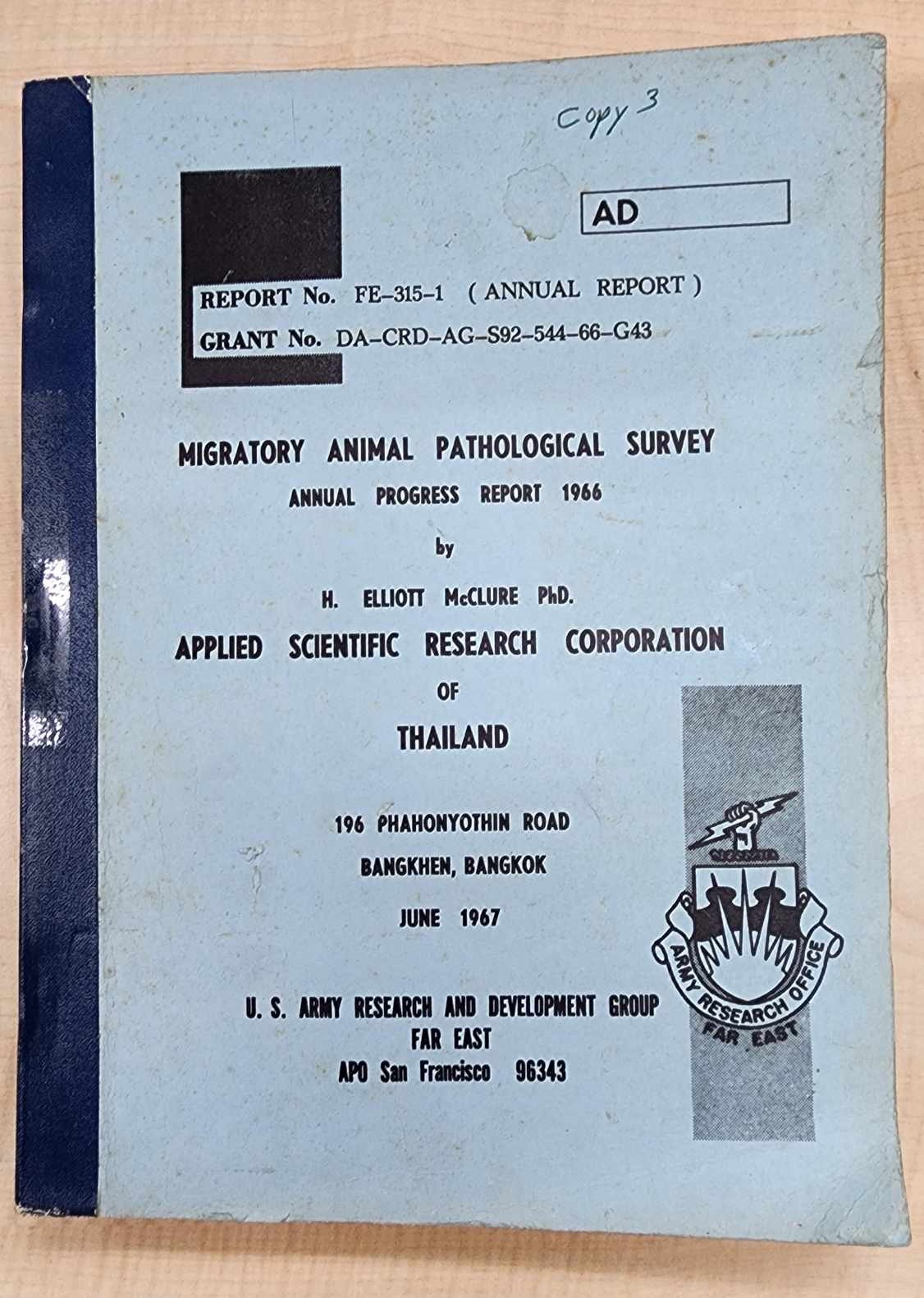
MAPS Annual Progress Report 1966 (Source: TWBF Archives)
News about this study was brought to Taichung City's Tunghai University by Prof. Ke-Qin Sun, who previously had worked in the Second Research Unit of the US Navy (NAMRU II) in Taipei. Prof. Paul Alexander of the Biology Department of Tunghai University agreed to lead the Taiwan project, but it was Sheldon Severinghaus, a newcomer to the University, who spearheaded the fieldwork. Taiwanese ornithologist and former TWBF president Lucia Liu Severinghaus took part in the MAPS project. As she put it,“Alexander had a degree in physiology. He loved birds and watched birds but was not a field person. My husband (Sheldon Severinghaus) had a B.S. in zoology and was a birdwatcher who had participated in field research programs growing up. He arrived at Tunghai University when the MAPS program was starting. He asked Alexander and received permission to attend the first meeting on campus as an observer.”
According to her account, Alexander gave S. Severinghaus the green light to lead the Taiwan field teams, train the workers, and manage the field program in Taiwan. The project started with international training programs organized by McClure to standardize field procedures and data collection. There were annual international meetings involving all the field team leaders to share information and to strengthen cooperation. The Taiwan field program lasted from 1964 to 1971, with only one species banded in 1971. By the time the project ended, the Taiwanese team had captured and banded more than 160,000 birds (3).
The MAPS project collected a large amount of important knowledge on avian migration in Taiwan and in Asia. It remains the only large-scale study in Taiwan to the present day (6). It also produced most of Taiwan's first generation of ornithological field researchers. In addition, those trained during the MAPS project subsequently played a decisive role in the development of Taiwanese birdwatching (1, 3).
It was around the mid- to late 1960s that the idea of birdwatching was introduced to the Taiwanese public. One of the first efforts in this area came from S. Severinghaus, who wrote a column in the English-language newspaper The China Post aimed at helping people recognize wild birds (6). These materials were later compiled and published in 1970 as Taiwan's first bird guide, A Guide to the Birds of Taiwan. Written by S. Severinghaus, Alexander, and student Kang Guo-wei, the guide contained information in both English and Chinese on 117 species (3, 4).
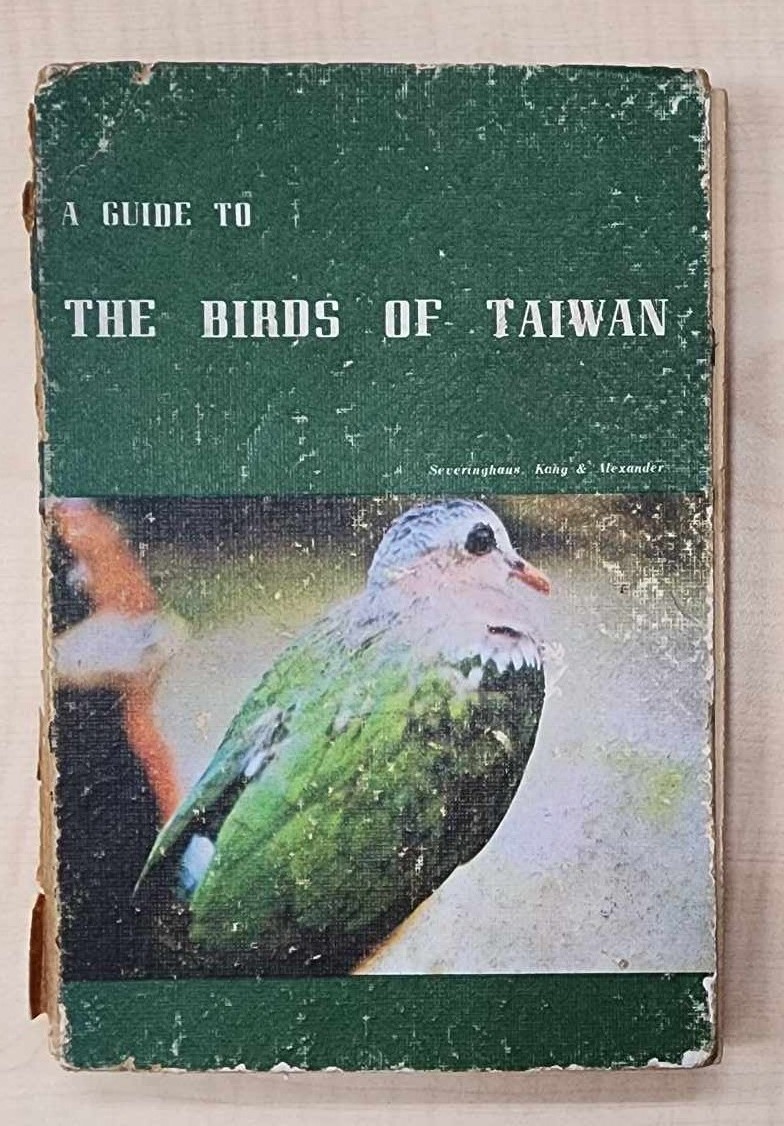
Taiwan's first bird guide published in 1970 (Source: TWBF Archives)
Bringing Birds to the People (1970s and 1980s)
The early 1970s saw the ornithological seed4 Lings planted in the 1960s begin to bear fruit. In 1972, while the MAPS project was ending, Taiwan's Forestry Bureau (now the Forestry and Nature Conservation Agency) launched the Ecological Survey of Forest Birds of Taiwan. Lasting until 1975, it was both the first research ever funded by the Taiwan government, and the first bird research solely conducted by Taiwanese ornithologists, mainly carried out by former MAPS workers Peter Chen and Yan Chong-wei (1, 2). Meanwhile, S. Severinghaus did his PhD at Cornell, focusing on Mikado and Swinhoe's Pheasants. This was the first Taiwan-specific study of individual species in the post-war era (4). In 1974, the Forestry Bureau adopted recommendations by S. Severinghaus based on his PhD study and established the Chuyunshan Wildlife Protected Area in southern Pingtung County. The move stopped logging across 6,200 ha of mixed broadleaf-conifer forest, which was prime habitat for Swinhoe's Pheasants and numerous other species, and which made up the largest protected area of that time (6).
Outside of academia, birdwatching was beginning to gain traction. On September 5, 1973, in the Tamsui apartment of American Jack Moyle, about a dozen Taiwanese and Americans gathered to discuss their interest in birdwatching. As L. Severinghaus, who attended these gatherings, put it, "Americans in those days had large Western-style homes. Moyle would invite bird-loving friends to come and share food and chat about what birds they recently saw. It planted the seed for forming a birdwatching club in Taipei. That was how it got started.”
This group used the English name the Taiwan Bird Watcher's Club of the ROC, and it was the forerunner of the Wild Bird Society of Taipei (2). In 1974, it became registered with the government as the Taipei City Bird Club under the tutelage of the Animal Protection Agency of the Republic of China. This affiliation was necessary since at the time Taiwan was under martial law and it was illegal to declare an association. The ruling Kuomintang limited the forming of civic groups to one per category of affiliation. The APA was already related to animals and sponsored by Chaing Kai-shek (2, 3).
In 1973, Blackshaw and S. Severinghaus, both Americans, initiated a Christmas Bird Count in the Lushan area of Nantou County based on the Christmas Bird Count events conducted in the US. As L. Severinghaus put it, "Ken Blackshaw was especially enthusiastic in promoting this since he had always been active in Christmas bird counts in the USA. [Sheldon] and I were living at Tunghai University. So, we talked to Alexander and decided to hold the first count at Lushan.”
Over 30 birdwatchers from all over Taiwan took part. As L. Severinghaus explained, "There were a number of Tunghai students, faculty, and various birdwatchers from other parts of Taiwan. We stayed in the same lodge and the count took place on one day. We were divided into groups and assigned specific areas, then shared the results.”
After 1976, the event was supported by the Taiwan Tourism Bureau and held on New Year's Day, rather than Christmas. The count also grew in size, taking place in three areas: Yangmingshan in the north, Hehuanshan in central Taiwan, and Kenting in the south (4, 2). The Taipei City Bird Club went on to manage the count in the north. NYBC counts were carried out until 1983 (2). However, due to issues related to sponsorship as well as survey systemization and schematics, the count stopped until a revival took place some 30 years later (2).
At the same time, outside of Taipei, there were also movements underway. Peter Chen and Yan Chong-wei were connecting with important members of other burgeoning groups such as John Wu Sen-hsiong in Taichung and Paul Chen in Kaohsiung. They would work with them and other like-minded individuals to help form birdwatching groups in Taichung (1975) and Kaohsiung (1979), both also under the umbrella of the Animal Protection Association (7, 8). These were the precursors of the Wild Bird Association of Taiwan (in Taichung) and the Kaohsiung Wild Bird Society, respectively (2).
Efforts to support birdwatching activities continued in the 1970s. It was not limited to newly forming birdwatching groups either. The Tourism Bureau, under the Ministry of Transportation and Communications, also promoted birdwatching activities during this time thanks to the efforts of Wild Bird Club of Taipei member, Hunter You. The bureau even sponsored bird surveys of the Lanyang River Estuary in Yilan County as well as heronries throughout Taiwan proper (6).
New guidebooks also helped further the reach of birdwatching. In 1976, the New Guide to the Birds of Taiwan was published. This version, by S. Severinghaus and Blackshaw, covered 201 species, had color pictures, and featured both English and Chinese descriptions. The Chinese in this guide also included Zhuyin phonetic pronunciations for the traditional Chinese characters. This helped many pronounce the names of the birds, opening the language of birding and ornithology to laypeople (4). In 1980, another guide was published by Zhang Wan-fu, another of the founding members of Taichung Birdwatching Club. It was the most complete guide since World War II, featuring 390 species and was also the first guide compiled entirely by local authors using local information (4). The Zhang guide would serve as the predecessor of numerous other guides and information books on birds published in Taiwan.
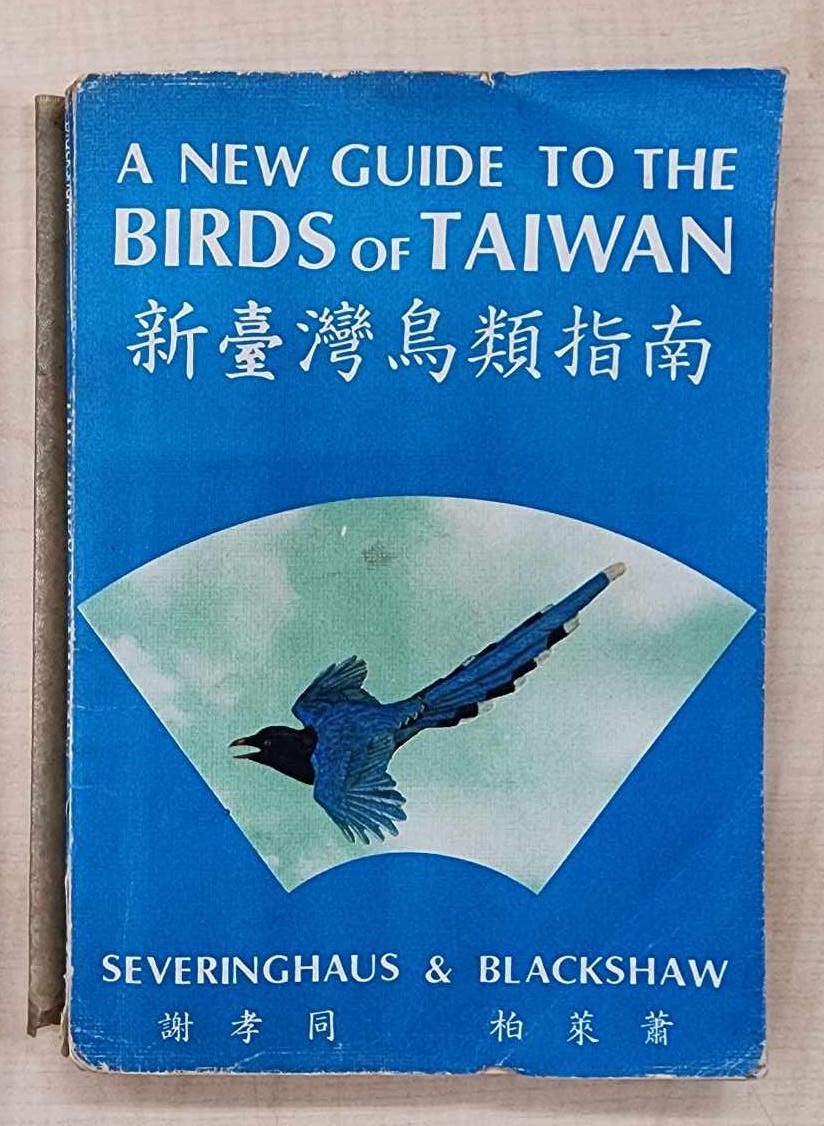
Taiwan's second bird guide published in 1976 (Source: TWBF Archives)
In March 1979, the Wild Bird Club of Taipei published the inaugural issue of Wild Birds, Taiwan's first birdwatching periodical, which featured information on birding trips, recent observations, and general ornithological information. More and more people were becoming interested, and by 1980 the Taipei group had around 100 members (2).
However, Taiwan's fledgling birdwatching movement still encountered many obstacles and restrictions due to strict regulations under martial law. Import restrictions led to high prices for binoculars, pairs of which were often shared among birdwatchers (2, 6 ). Scopes were even more difficult to come by, and were usually procured on business trips to Japan or through friends. Moreover, simply having such items in your possession could bring scrutiny from authorities (2). Meanwhile, without guides, new birdwatchers in Taiwan relied heavily on international friends for information on bird identification and other materials. There were also heavy restrictions on where birdwatching was possible. Most mountainous areas were restricted, with general citizens not having access under 'mountain access regulations'. Any place that was considered sensitive to national security was also off-limits, this included many coastal areas, as well as wetland areas and especially estuaries. At times these areas even had soldiers on guard as a means to deter trespassing (2).
Yet despite these restrictions, people continued to birdwatch. In 1982 the Taipei birdwatching group would rename itself the Wild Bird Society of Taipei and in 1984, it would become its own organization. The group by that point had already been involved in society-level activities when in fall 1978 members went to investigate the hunting of Grey-faced Buzzards in Pingtung County's Manzhou Township (2). This investigation went hand-in-hand with work being done by certain other groups like the Taichung Bird Watching Club, led by John Wu Sen-hsiong. In the late 1970s, while Wu was on a business trip to the US and Japan, the national Audubon Society and Wild Bird Society of Japan held meetings with him on Brown Shrikes and Grey-faced Buzzards, respectively. These two migratory species in Taiwan were heavily threatened by hunting at that time (5). Though conservation and ornithological study in Taiwan was only in its early days and the country was still under martial law, Taiwan's biodiversity and environmental threats were already being discussed internationally.
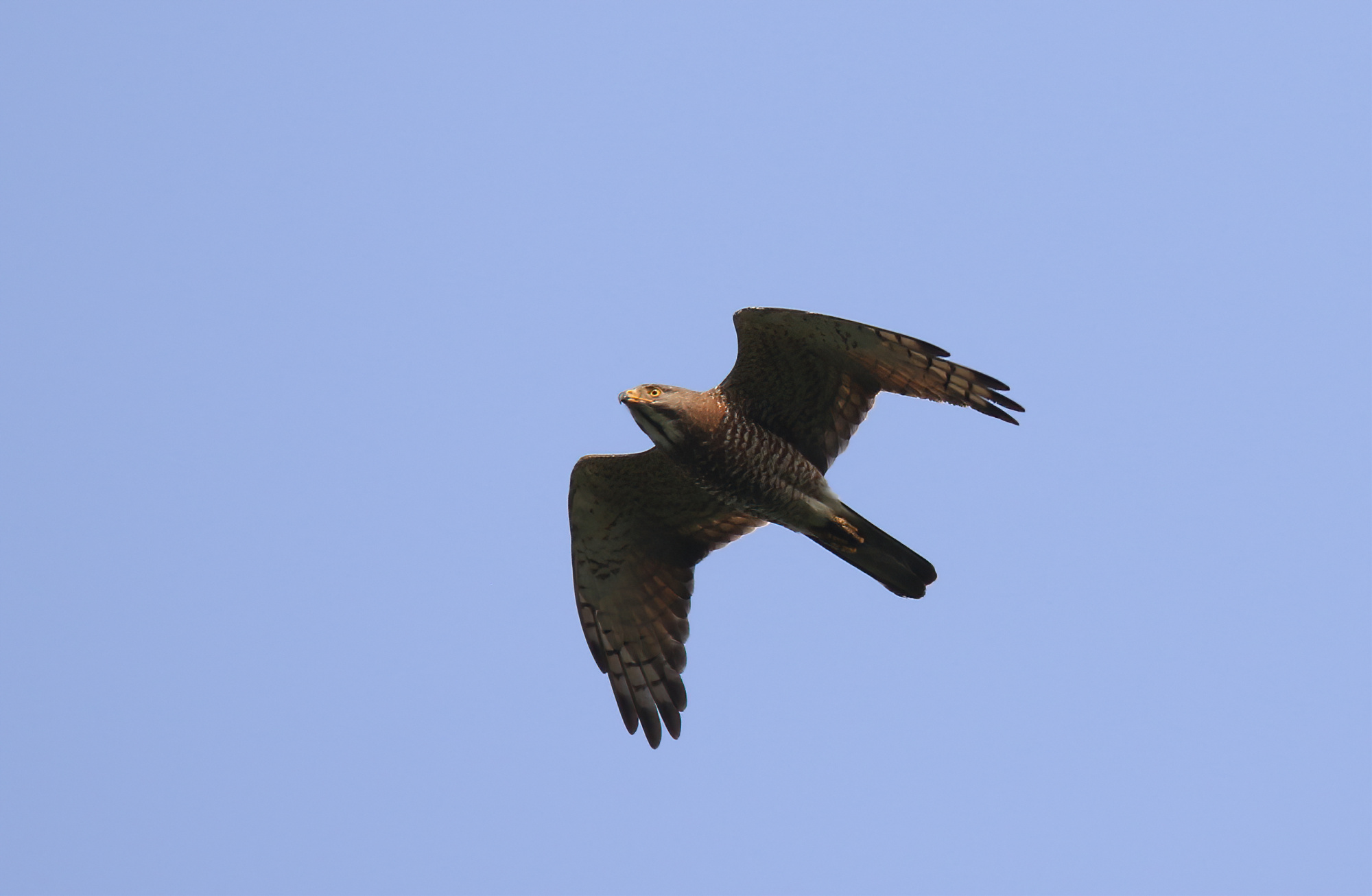
Grey-faced Buzzard (Source: TWBF)
From the early 1980s, the central government created new laws and studies to better understand Taiwan's environment and ecosystems. For instance, the Construction and Planning Administration (CPA) under the Ministry of the Interior in 1981 established a National Parks Division, which was tasked with setting up Taiwan's national park system (6). Kenting National Park, Taiwan's first national park, was established in 1984 to help conserve the natural resources and species diversity there, including Grey-faced Buzzards (3). In 1982, with the promulgation of the Cultural Heritage Preservation Act, certain plant and animal species were declared natural cultural landscapes. Nine bird species, such as the Mikado Pheasant and Mountain Hawk Eagle, gained protection under the law. Also in 1984, the Council of Planning and Development of the Ministry of Economic Affairs included nature conservation as one of the "Fourteen Important Constructions for the Coming Six Years" (6). As a result, a conservation unit was added to the Forestry Bureau under the Council of Agriculture (COA) and charged with research on nature and wildlife conservation, establishing conservation areas, and promoting public education on nature conservation (6).
By this point, some of the Taiwanese students who studied at Tunghai University or former participants in the MAPS program were now teachers, and the activity of birdwatching was spreading, with three groups in northern, central and southern Taiwan. Individuals such as Peter Chen, John Wu, and Lucia Liu Severinghaus were connecting with international groups and organizations in the rapidly developing field of ornithology and conservation in Taiwan. In 1982, the 1st East Asian Bird Protection Conference was held in Korea, with representatives from Korea, Japan and Taiwan (2). Taiwan's Animal Protection Association and Tunghai University went on to host the 2nd East Asian Bird Protection Conference in Taiwan. On that occasion, representatives from Japan, Indonesia, Korea, the Philippines, Thailand, and the US attended. Internationally known ornithologist and then-director of the International Council on Bird Protection (ICBP) Dr. Christoph Imboden gave the opening address. Together these developments thrust Taiwan's conservation efforts into the international spotlight (5).
At the same time, members of the general public were engaging with birds and birdwatching more than ever before amid growing local interest and the increasing promotion of birdwatching activities in newspapers. Also, after the campaigns to help save the Grey-faced Buzzards and Brown Shrikes, the public were gaining more of an appreciation for, and interest in, Taiwan's natural environment. In 1985, a series of birdwatching events held from April 14 to May 5, 1985, co-hosted by the Minsheng Daily newspaper and the Wild Bird Society of Taipei at Guandu Wetland, was attended by over 10,000 people (2).
Part 2 will look at the founding of the TWBF and its early years.
References:
(1) Ding, TS. 2001. A Checklist of the Birds of Taiwan. Retrieved 5/13/2023
http://homepage.ntu.edu.tw/~ding/aves/chklst_index.htm
(2) Hsieh, CK. (2017). The Shaping and Promotion of Ornithology and Birdwatching in Taiwan (1945-1989), [Doctoral Dissertation National Chengchi University]. National Chengchi University Electronic Theses and Dissertations (中文)
http://thesis.lib.nccu.edu.tw/cgi-bin/gs32/gsweb.cgi?o=dallcdr&s=id=%22G0102158017%22.&searchmode=basic
(3) Keck, F. 2015. Sentinels for the environment. Birdwatchers in Taiwan and Hong Kong. China Perspectives, 2015 (2015/2), 43-52.
https://journals.openedition.org/chinaperspectives/6723
(4) Lin, WH. 1997. The Discovery of the Birds of Taiwan. Yushan Press. Taipei, Taiwan. (中文)
(5) Rogers, Kate. 2006. The Swallows’Return: A Foreigner's History of Birdwatching, Conservation, and Culture in Taiwan, translated by Chen Wei-4 Lin, Nantou County, Jiji Township, Taiwan Endemic Species Research Institute.
(6) Severinghaus LL, Ding TS, Fang WH, 4 Lin WH, Tsai MC, Yen CW. 2017. The Avifauna of Taiwan. Vol. 2. Forestry Bureau, Council of Agriculture, Taipei, Taiwan.
(7) Wang, JD. 1999. The Kaohsiung Wild Bird Society at 20. Chinese Wild Bird Federation. 中華飛羽 135 (11): 6-8. (中文) https://www.bird.org.tw/sites/default/files/field/file/download/%E4%B8%AD%E8%8F%AF%E9%A3%9B%E7%BE%BD135%E6%9C%9F-1999-11-%E9%81%AE.pdf
8) Wild Bird Association of Taiwan. Association History. Retrieved 9/12/2023. (中文)
http://www.birdtaiwan.com/RWD/M1_1/tw/1378/1273/554
